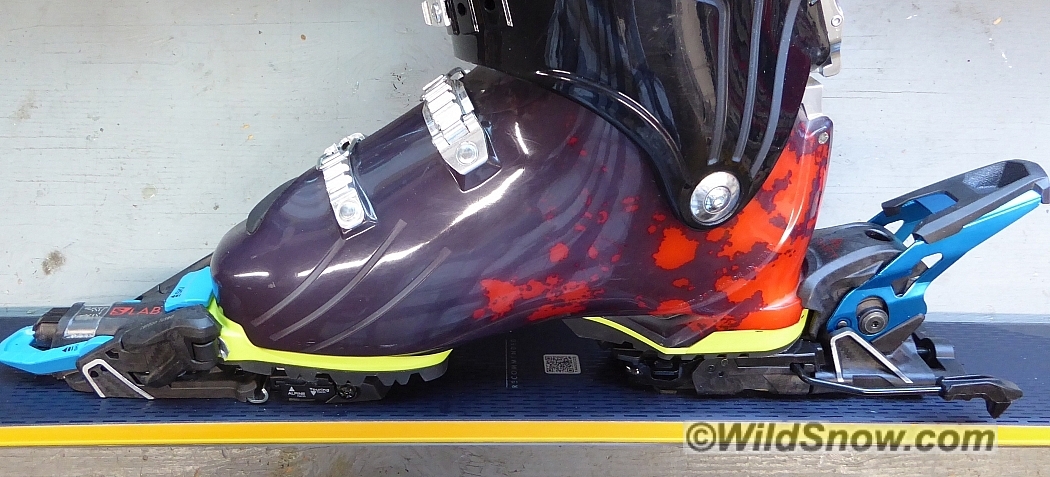
Sure, you can use those Solomon Shifts on your resort skiing days, but if you ski on piste a lot, you might want to consider otherwise.
An economic argument for the quiver of two
I see it often. In the field and on the internet. People want one set of ski gear to use inbounds and out. This is a noble goal. In a consumerist world, reducing our consumption is a worthy pursuit. However, if you spend a lot of time skiing inbounds, your experience will be dramatically and negatively influenced by choosing “hybrid” resort/backcountry ski gear as a “quiver of one”.
Further, it isn’t the cost savings you would hope for. Let’s just look at some numbers. All costs drawn directly from retail shops on the web. I sought equipment sized for me, with skis around 180-185cm. Skins and poles omitted, because in either case you’ll need one pair of each. You can go budget or deluxe with skins and poles, but those choices aren’t wrapped up with the rest of your gear choices like skis, boots, and bindings are.
A random, semi-budget, semi-light, “quiver of one” set up, with numbers for cost and weight.
Dynafit Beast 184 ski. 1600g per ski. $700
Salomon Shift. 850g per ski. $725
Scarpa Maestrale XT. 1490g per boot. $899
This makes for a total set-up weight of 7.9kg and a total cost of $2324.
Now, let’s look at accomplishing this same thing with two sets of ski gear.
First, your resort gear. To replicate the resort performance of the above, you can secure an intermediate level set of equipment for about $1000. Its weight doesn’t matter, as you won’t carry it uphill for hours and days. I won’t do the shopping for you, but I can tell you that the above “crossover” gear skis about the same as intermediate, budget-level resort gear.
Next, let’s compare to a budget set of equipment primarily for human-powered skiing. Your typical, “daily driver” sort of backcountry ski set up. Some places will cut you a deal on packages, but we’ll leave that out of the equation for simplicity.
Voile V6. 1500g per ski. $695
Dynafit Speed Turn. 370g per binding. $350
La Sportiva Spectre 2.0. 1445g per boot. $679
Here you end up with a package that costs $1724 and weighs 6.6kg.
Compare the costs, and, yes, you save some dollars with the “quiver of one”. Specifically, you save dollars at initial purchase. The quiver of one costs about $2300 while the two-ski set up costs $2700. What do you get for those $400? Well, most obvious is that you save 1.3kg. That’s well over a pound per foot. That makes a big difference in your backcountry experience. Shop more carefully than I did and you can trim even more weight from your touring gear with minimal to no additional cost.
Less obvious is that, with the two-ski arrangement, you get to reap the value of your backcountry ski set up much, much longer. Way more than twice as long. Using that expensive, “lightweight” quiver of one touring gear at the resort will be extremely hard on it. Just yesterday I skied a rather average resort day and logged 20000 vertical feet on my Garmin. Even in this amazing Teton pow month it takes me a whole week to rack that up in the backcountry. Every turn downhill stresses and wears your ski gear. All ski bindings, with their moving parts, wear out with every downhill vertical foot. “Crossover” bindings have more moving parts than either dedicated touring bindings or dedicated resort bindings. This makes them both more expensive and less durable than either one.
Resort gear ages too, but not nearly as fast. However, for arguments’ sake, let’s assume that it wears out just as fast as backcountry gear, given equal use. Fast forward ten years in the two scenarios above. You ski enthusiastically. Say, 15-20 resort days a year and about the same in the backcountry.
With the quiver of one, you’ll replace that kit roughly every two years. That’s five setups at $2300 each for a grand total of $11500 over a decade.
With the “quiver of two”, more math is required. Your resort gear will wear out at about the same rate. Five intermediate setups at $1000 each, so $5k. Your touring gear, though, will hold up much better now. Maybe, just maybe, you’ll have to replace it in five years. Sure, many replace their gear more frequently. But they’re not budget oriented like you are, right? That’s two setups. And all are optimized for what you use them for. $3400 for two BC setups. $8400 for ski gear over 10 years.
Round it all up, a lot, and you’re still way ahead of the cost of the “quiver of one” strategy. Over ten years, roughly, the crossover strategy costs nearly $12k, while maintaining two sets of more specialized ski gear costs under $9k. The “quiver of one” set up, compiled of ever-trendy, but often under-delivering “crossover” backcountry ski gear, is what my mom would call “penny wise and pound foolish”.
Postscript:
Now, how about traveling? Isn’t it less hassle to just travel with one set-up? Sure, it is. But it is not twice the hassle or expense to travel with two pairs of skis and boots. With your long-term savings, get yourself a baller, padded, rolling ski bag that fits two pairs of skis. Traveling with a spouse or ski partner? I’ve put 3-4 pairs of skis in one such bag. Pack it with clothes etc to get it up near 50 lbs. Airline rules are ever changing, but I’ve never had a problem, jumping continents and states and regions, with such a bag and 2+ sets of skis.
Jed Porter is a passionate adventure skier and all-around mountain professional. His primary work is as a mountain guide, skiing and climbing all over the Americas and beyond. Learn more about him at his website linked below.
